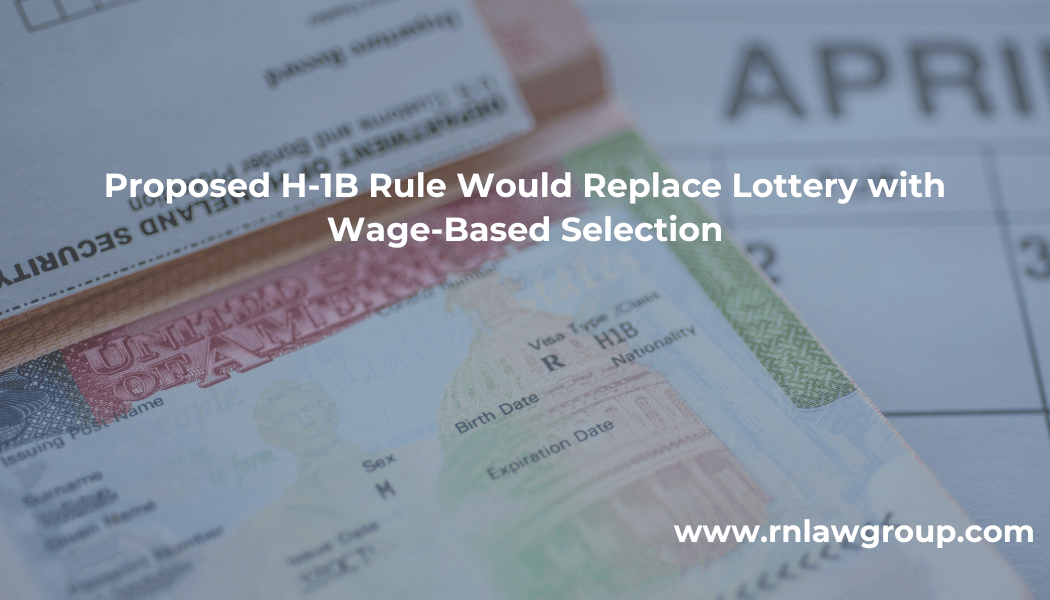
Proposed H‑1B Rule Would Replace Lottery with Wage-Based Selection
The Department of Homeland Security (DHS) has introduced a proposal (RIN 1615-AD01) to change the way H-1B visas are awarded. Currently, the system is based on a random lottery, but DHS wants to replace this with a new system that gives priority to higher-paying jobs. This change could dramatically alter who receives these coveted visas and how companies hire foreign talent.
Right now, each year employers apply online to register potential foreign workers for H-1B visas. If there are more registrations than available visas (usually 85,000 per year), a random lottery decides which applications can move forward. This system treats all registrations equally—whether from a small startup offering modest salaries or a large corporation paying high wages.
Under the new proposal, employers would have to provide information about how much they plan to pay each worker when registering. The government uses four salary levels—Level I (entry-level) to Level IV (experienced)—based on job location and occupation. Visas would first go to those offering Level IV salaries, then Level III, and so on, until all visas are issued. If there are more applicants within any level than available visas, a lottery within that wage level would occur.
Here’s a simple comparison of the two systems:
|
Aspect |
Current System |
Proposed System |
|
Selection Method |
Completely random lottery. |
Prioritize by wage level; random lottery within each wage tier. |
|
Wage Consideration |
None |
Higher wages increase the chance of selection. |
|
Impact on Employers |
All employers have equal chances. |
Companies offering higher salaries have better chances. |
|
Impact on Workers |
Equal opportunity regardless of experience or salary offered. |
Highly paid, experienced workers favored; entry-level positions rarely chosen. |
This proposal originally came from the Trump administration, motivated by a goal to shift the U.S. immigration system toward merit-based selection. The idea is that by favoring higher wages, companies would be encouraged to raise salaries for foreign professionals, reducing pressure on wages overall and protecting American jobs. DHS believes that this would ensure H-1B visas go primarily to highly skilled workers in critical roles, aligning with the idea that immigration should benefit the U.S. economy by attracting top talent.
Supporters of the new system argue it would raise the overall quality and wages of H-1B visa holders. Higher salaries usually reflect more specialized or advanced skills, ensuring that visas go to workers who truly add value. Supporters also say it would reduce the misuse of the visa program, where some companies use it mainly to fill positions at lower wages instead of hiring domestic workers.
However, there is strong opposition from smaller businesses, startups, universities, and immigration attorneys. Critics argue that prioritizing higher wages heavily favors large corporations that can afford to pay top salaries, disadvantaging small businesses and startups. They also worry it could effectively block entry-level positions, making it hard for recent international graduates from U.S. colleges to find jobs. These concerns suggest that fewer international students might choose to study in the U.S., knowing their job prospects could diminish.
If the new rule goes into effect, entry-level workers or those offered lower salaries will likely see their chances of getting an H-1B visa drop significantly. Companies might have to raise salaries, hire fewer foreign workers, or try hiring locally. On one hand, this could lead to better pay and conditions for foreign workers. On the other hand, it could result in certain essential jobs going unfilled if companies can’t afford higher wages.
Critics also highlight potential unintended consequences: smaller cities and certain industries could struggle if the required salary to compete for visas is too high, creating imbalances in where jobs and talent flow.
The proposal is currently under review. Next, DHS will invite public comments before making a final decision. Depending on political support and public feedback, the rule could become official by late 2025 or 2026. The outcome will greatly depend on the political environment and whether future administrations favor this merit-based approach.
Overall, this proposal represents a major potential shift in U.S. immigration policy, prioritizing higher-paid professionals and changing how businesses use foreign talent. Whether this shift will benefit or harm the economy and job market is the heart of ongoing debates. Stakeholders—both supporters and critics—will closely watch the proposal’s next steps, knowing the future of H-1B visas could soon look very different.
By: Rahul Reddy & Steven Brown
Rahul Reddy is the founding partner of Reddy Neumann Brown PC. He founded our firm in 1997 and has over 28 years of experience practicing employment-based immigration. Rahul‘s vast knowledge of the complex immigration system makes him an invaluable resource and an expert in the field. His personal experience with the immigration system has made him empathetic to each of his clients’ cases and empowered him to help others achieve the American Dream.
Rahul‘s dedication to serving the immigrant community is evident, from his daily free conference calls to his weekly immigration Q&As on Facebook and YouTube Live. He is an active member of the immigrant community and one of the founders of ITServe Alliance. He has been a member of American Immigration Lawyers Association since 1995.
Steven A. Brown is a Partner at Reddy Neumann Brown PC, where he leads the firm’s Litigation Team, addressing delays and denials of immigration benefits, FOIA requests, and policy and regulatory challenges. Steven is dedicated to delivering practical and effective solutions for clients facing unreasonably delayed or unlawfully withheld immigration benefits, including Employment Authorization Documents (EADs), advance parole, green cards, 221(g) decisions, EB-5 delays, and other immigration-related matters. His litigation efforts were instrumental in Shergill, et al. v. Mayorkas, a landmark case that led to the U.S. government recognizing that under the INA, L-2 and E visa spouses are authorized to work incident to their status, eliminating the need for separate EAD applications. This case has transformed work authorization for thousands of families across the United States.


